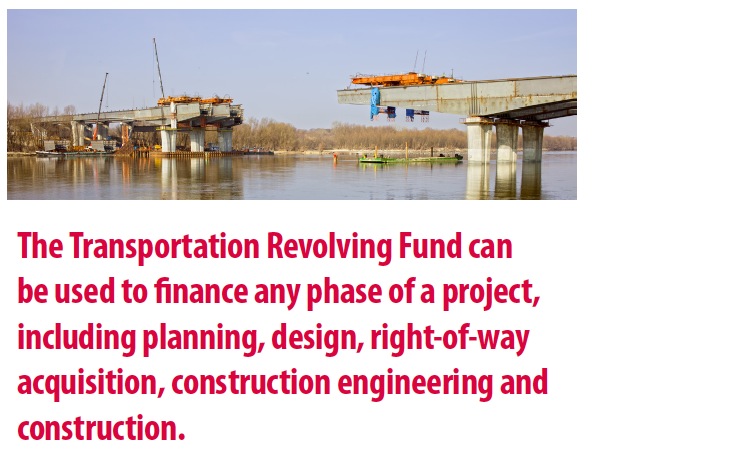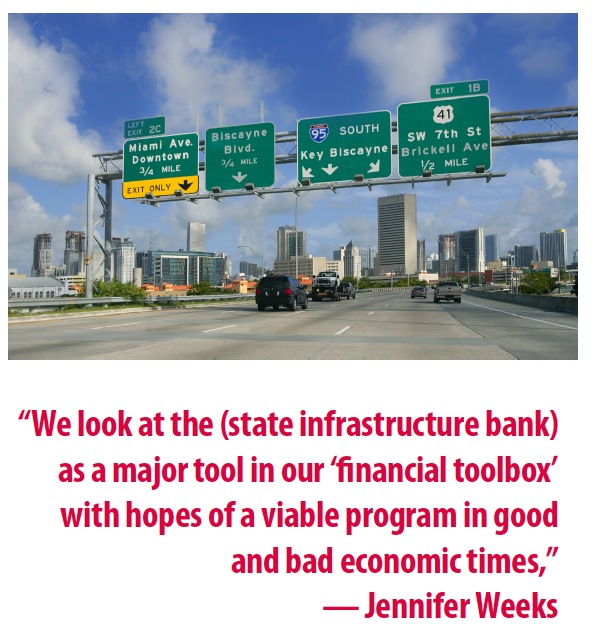THE COUNCIL OF STATE GOVERNMENTS
An interchange at the Fort Lauderdale airport. A bridge replacement in Cleveland. An interstate around North Augusta, S.C., that will help ease the daily commute for thousands of motorists.
The thing they all have in common is that they were all financed with help from a state infrastructure bank, a type of revolving infrastructure investment fund for surface transportation projects with which 32 states and Puerto Rico have at least some experience.
Operating much like other kinds of banks, these infrastructure banks can offer loans and credit assistance enhancement products to public and private sponsors of certain highway construction, transit or rail projects.
Under the 2005 federal highway authorization bill, known as SAFETEA-LU, all states and territories plus the District of Columbia were given the authority to establish state infrastructure banks. This followed a period during the 1990s when at different times, anywhere from 10 to 39 states were allowed to experiment with these banks under a series of federal pilot programs. The 2005 legislation also allowed for the creation of multi-state infrastructure banks.
Federal and state matching funds are generally used to start a state infrastructure bank. States can then contribute state or local funds and seek additional federal funds to provide more capital.
The bank’s initial capitalization and ongoing revenue can be used in a number of different ways. The funds can be lent directly to selected projects. The bank can leverage its initial capitalization by providing loan assistance, by using loan repayments as dedicated revenue to sell bonds in the bond market and by providing additional loan assistance with the proceeds of the bond. Finally, the bank can use the funds to guarantee bonds issued by cities, counties, public-private partnerships and other entities, in the process enhancing their creditworthiness and lowering the interest rates they have to pay in the capital markets. Loan guarantees can be particularly beneficial in reducing interest rates on projects in states with cities, counties and special districts that have limited financial capacity.
While the SAFETEA-LU authorization established the basic requirements and overall operating framework for state infrastructure banks, many states have tailored their banks to meet their own needs and offer their own types of financing assistance. That being said, loans remain the most popular form of state infrastructure bank assistance. The Federal Highway Administration reported that through the end of 2008 (the latest year for which complete data is available), 32 states and Puerto Rico had entered into 609 state infrastructure bank loan agreements totaling $6.2 billion.
Benefits of a State Infrastructure Bank
State infrastructure banks can help states stretch their state and federal dollars and meet the demands of financing large, impactful, long-term infrastructure projects. When government agencies and authorities must seek yearly grants and allocations to finance projects, the completion of those projects can be delayed for months or years. State infrastructure banks can identify, promote and lend money to creditworthy transportation projects to ensure they’re built within a reasonable timeframe and in a financially sustainable way. And because these banks act as a “revolving fund,” more projects can ultimately be financed.
When bonding is used to finance a project, the bonds are usually one of two types: revenue or general obligation. Revenue bonds often are used to finance infrastructure projects that have the ability to produce revenue through their operations; for example, new highway lanes that can be tolled or public transit facilities on which fares can be collected. These types of bonds are typically guaranteed by the project revenues, but not by the full faith and credit of a state, city or county. General obligation bonds, on the other hand, are backed by the full faith and credit of the issuing authority. These are used to finance projects that rely on government’s general revenues, such as income, sales and property tax revenue. Cities, counties and states pledge these revenues to issue the bonds and repay them.
But the revolving fund aspect of a state infrastructure bank means states can lend funds for projects and receive loan repayments, which can be returned to the system for more project loans. The funding also can be turned into much larger credit lines, multiplying transportation investment capacity.
When transportation projects are financed in a traditional way, funds from a state department of transportation or the federal Highway Trust Fund are spent and two types of risk are assumed. Projects are at risk of delay as state officials wait for the state or federal funds to become available, which may GOVERNMENTSincrease the costs and delay the project’s benefits. Secondly, states face the risk that a poorly selected project will fail to produce social or economic benefits and tie up scarce capital resources that could have gone to other potentially more successful projects.
Both of those risks are diminished with state infrastructure bank financing. First, projects don’t have to wait for funding and delays and cost overruns are avoided. Secondly, a state infrastructure bank has a built-in project evaluation process. Projects are assessed based on their financial viability, which provides a level of economic discipline that is not always present with traditional state project funding. Better, more benefit-producing projects can be the result.
Download full version (PDF): State Infrastructure Banks
About the Council of State Governments
www.csg.org
“The Council of State Governments is our nation’s only organization serving all three branches of state government. CSG is a region-based forum that fosters the exchange of insights and ideas to help state officials shape public policy. This offers unparalleled regional, national and international opportunities to network, develop leaders, collaborate and create problem-solving partnerships.”
Tags: Capitol Research, CSG, THE COUNCIL OF STATE GOVERNMENTS








 RSS Feed
RSS Feed